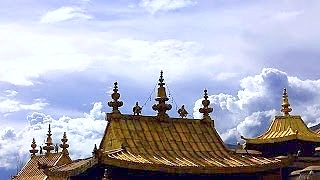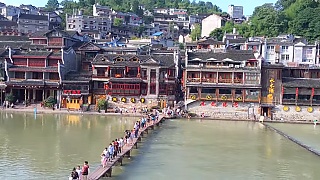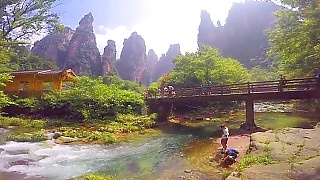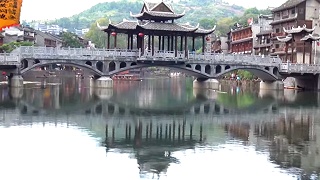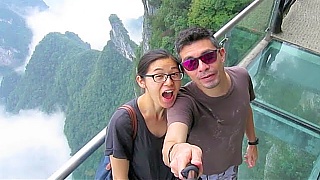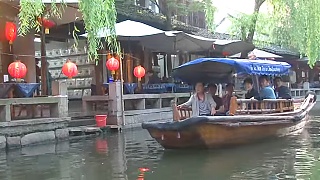With Sun Kissed Bucket List ...
[640],shadow=true,start=,stop=ZhangJiaJie, located in HuNan province, is renowned for its breathtaking natural landscapes, including towering sandstone pillars, lush forests, and deep ravines. It gained international fame as the inspiration for the floating Hallelujah Mountains in the movie "Avatar." This guide provides an in-depth look at the best attractions, activities, and tips for visiting Zhangjiajie.
Top Attractions
Zhangjiajie National Forest Park
Zhangjiajie National Forest Park, part of the larger Wulingyuan Scenic Area, is the primary attraction. It is famous for its quartz-sandstone pillars, some of which reach over 200 meters in height.
- Avatar Hallelujah Mountain: This iconic peak was renamed after the film "Avatar" and is one of the most photographed spots in the park.
- Yuanjiajie Scenic Area: Home to stunning vistas and the First Bridge Under Heaven, a natural rock bridge.
- Golden Whip Stream: A beautiful, serene area ideal for hiking, featuring crystal-clear streams and lush vegetation.
Tianmen Mountain
Tianmen Mountain is another must-see attraction, known for its dramatic scenery and thrilling experiences.
- Glass Skywalk: A transparent walkway that clings to the side of the mountain, offering vertigo-inducing views.
- Tianmen Cave (Heaven's Gate): A massive natural arch in the mountain, accessible via a long staircase.
- Tianmen Mountain Cableway: One of the longest cable car rides in the world, providing stunning aerial views.
Baofeng Lake
Baofeng Lake offers tranquil boat rides surrounded by stunning karst scenery. It's a great spot for relaxation and enjoying the natural beauty of the area.
Yellow Dragon Cave
Yellow Dragon Cave is a vast karst cave system featuring impressive stalactites, stalagmites, and underground rivers. It is known for its grand chambers and intricate rock formations.
Geology of Zhangjiajie
The unique geology of Zhangjiajie is what makes it so stunning. The area is characterized by its towering quartz-sandstone pillars that were formed through a combination of geological processes over millions of years. The region was once submerged under an ancient ocean, and over time, the uplift and erosion sculpted these dramatic formations. The pillars are a result of physical weathering, primarily caused by wind, frost, and the growth of plant roots, which break down the rock. The unique climate and vegetation of the area have also contributed to the landscape's current form.
Touring the Park
Planning Your Visit
To make the most of your visit to Zhangjiajie National Forest Park, it’s important to plan your route and time your visits to avoid the crowds. A typical visit to the park can take 2-3 days to cover the main highlights. Here is a suggested itinerary:
Day 1: Zhangjiajie National Forest Park
- Morning: Start early at the park's main entrance. Take the shuttle bus to the Yellow Stone Village area. Spend the morning exploring the trails and enjoying the panoramic views.
- Afternoon: Head to Golden Whip Stream for a peaceful hike along the stream. The trail is relatively flat and suitable for all ages.
Day 2: Yuanjiajie and Tianzi Mountain
- Morning: Take the park shuttle bus to the Yuanjiajie Scenic Area. Explore the Avatar Hallelujah Mountain and the First Bridge Under Heaven.
- Afternoon: Continue to Tianzi Mountain for more spectacular views. Take the cable car down for a different perspective.
Day 3: Tianmen Mountain
- Morning: Take the Tianmen Mountain Cableway from Zhangjiajie City to the top of the mountain. Walk along the Glass Skywalk for thrilling views.
- Afternoon: Visit Tianmen Cave (Heaven's Gate). Descend via the 999 steps or take the escalator.
Activities and Experiences
Hiking
Zhangjiajie offers numerous hiking trails that cater to all levels of fitness. Popular hikes include the Golden Whip Stream trail and the various paths around Tianzi Mountain and Yuanjiajie Scenic Area.
Photography
The unique landscapes of Zhangjiajie provide endless opportunities for photography. Key spots include the Avatar Hallelujah Mountain, the Glass Skywalk, and the views from the Tianmen Mountain cable car.
Local Cuisine
Try local Hunan cuisine, known for its bold flavors and use of chili peppers. Signature dishes include spicy fish head, fried rice noodles, and various stir-fried meats and vegetables.
Travel Tips
Best Time to Visit
The best times to visit Zhangjiajie are spring (April to June) and autumn (September to November) when the weather is mild and the scenery is at its most vibrant. Summer can be hot and crowded, while winter offers fewer tourists and a different but beautiful snowy landscape.
Getting There
Zhangjiajie is accessible by train, bus, and air. The Zhangjiajie Hehua International Airport has flights from major Chinese cities. There are also direct trains and buses from Changsha, the capital of Hunan Province.
Accommodation
There are numerous accommodation options ranging from budget hostels to luxury hotels. Staying in Wulingyuan Town provides easy access to the national park, while Zhangjiajie City offers more amenities and is closer to Tianmen Mountain.
Tickets and Passes
Purchase tickets for the Wulingyuan Scenic Area, which includes Zhangjiajie National Forest Park, online or at the entrance. Consider buying a multi-day pass if you plan to explore the area thoroughly. Separate tickets are required for Tianmen Mountain and other attractions.
Guides and Tours
Hiring a local guide can enhance your experience, providing insights into the area's history, culture, and natural features. Many tour operators offer packages that include transportation, tickets, and guided tours.

 Taz and Libby visit awesome ZhangJiaJie, HuNan province
Taz and Libby visit awesome ZhangJiaJie, HuNan province





